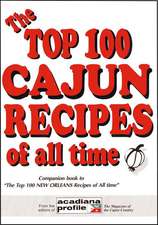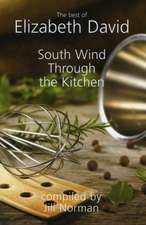La Cuisine Creole: A Collection of Culinary Recipes from Leading Chefs and Noted Creole Housewives, Who Have Made New Orleans Famous for: Cooking in America
Autor Lafcadio Hearnen Limba Engleză Paperback – 30 sep 2007
Published circa 1885, this pioneering work compiles the recipes of New Orleans in one volume. Celebrating the range of ethnic influences on Creole cuisine, the book contains recipes for many of the classic New Orleans dishes. Written by Lafcadio Hearn, one of New Orleans greatest literary talents, it shows a more literary flair than most modern cookbooks.
| Toate formatele și edițiile | Preț | Express |
|---|---|---|
| Paperback (2) | 136.44 lei 3-5 săpt. | |
| Applewood Books – 30 sep 2007 | 136.44 lei 3-5 săpt. | |
| Janaway Publishing, Inc. – 30 apr 2012 | 177.36 lei 6-8 săpt. |
Din seria Cooking in America
-
 Preț: 255.21 lei
Preț: 255.21 lei -
 Preț: 238.15 lei
Preț: 238.15 lei -
 Preț: 146.27 lei
Preț: 146.27 lei -
 Preț: 72.96 lei
Preț: 72.96 lei -
 Preț: 66.64 lei
Preț: 66.64 lei -
 Preț: 146.08 lei
Preț: 146.08 lei -
 Preț: 85.96 lei
Preț: 85.96 lei -
 Preț: 88.74 lei
Preț: 88.74 lei -
 Preț: 246.91 lei
Preț: 246.91 lei -
 Preț: 180.45 lei
Preț: 180.45 lei -
 Preț: 166.15 lei
Preț: 166.15 lei -
 Preț: 195.64 lei
Preț: 195.64 lei -
 Preț: 202.17 lei
Preț: 202.17 lei -
 Preț: 180.45 lei
Preț: 180.45 lei -
 Preț: 65.19 lei
Preț: 65.19 lei -
 Preț: 87.51 lei
Preț: 87.51 lei -
 Preț: 196.64 lei
Preț: 196.64 lei -
 Preț: 145.26 lei
Preț: 145.26 lei -
 Preț: 173.31 lei
Preț: 173.31 lei -
 Preț: 115.95 lei
Preț: 115.95 lei -
 Preț: 203.84 lei
Preț: 203.84 lei -
 Preț: 231.82 lei
Preț: 231.82 lei -
 Preț: 196.23 lei
Preț: 196.23 lei -
 Preț: 134.97 lei
Preț: 134.97 lei -
 Preț: 160.40 lei
Preț: 160.40 lei -
 Preț: 87.51 lei
Preț: 87.51 lei -
 Preț: 136.25 lei
Preț: 136.25 lei -
 Preț: 211.41 lei
Preț: 211.41 lei -
 Preț: 180.86 lei
Preț: 180.86 lei -
 Preț: 167.38 lei
Preț: 167.38 lei -
 Preț: 117.18 lei
Preț: 117.18 lei -
 Preț: 166.97 lei
Preț: 166.97 lei -
 Preț: 319.83 lei
Preț: 319.83 lei -
 Preț: 118.45 lei
Preț: 118.45 lei -
 Preț: 79.72 lei
Preț: 79.72 lei -
 Preț: 67.22 lei
Preț: 67.22 lei -
 Preț: 113.90 lei
Preț: 113.90 lei -
 Preț: 80.19 lei
Preț: 80.19 lei -
 Preț: 129.69 lei
Preț: 129.69 lei -
 Preț: 178.59 lei
Preț: 178.59 lei -
 Preț: 173.94 lei
Preț: 173.94 lei -
 Preț: 240.59 lei
Preț: 240.59 lei -
 Preț: 240.59 lei
Preț: 240.59 lei -
 Preț: 239.27 lei
Preț: 239.27 lei -
 Preț: 188.66 lei
Preț: 188.66 lei -
 Preț: 153.48 lei
Preț: 153.48 lei -
 Preț: 96.86 lei
Preț: 96.86 lei -
 Preț: 292.56 lei
Preț: 292.56 lei -
 Preț: 123.52 lei
Preț: 123.52 lei -
 Preț: 137.89 lei
Preț: 137.89 lei
Preț: 136.44 lei
Nou
Puncte Express: 205
Preț estimativ în valută:
26.11€ • 27.16$ • 21.56£
26.11€ • 27.16$ • 21.56£
Carte disponibilă
Livrare economică 24 martie-07 aprilie
Preluare comenzi: 021 569.72.76
Specificații
ISBN-13: 9781429090117
ISBN-10: 1429090111
Pagini: 272
Dimensiuni: 154 x 230 x 17 mm
Greutate: 0.4 kg
Editura: Applewood Books
Seria Cooking in America
ISBN-10: 1429090111
Pagini: 272
Dimensiuni: 154 x 230 x 17 mm
Greutate: 0.4 kg
Editura: Applewood Books
Seria Cooking in America
Recenzii
Who in the world is Lafcadio Hearn? If you live in Japan, you're sure to know. But if you're American - even if you're from New Orleans, where he lived and wrote for 10 ferociously productive years - probably not. It's Mardi Gras season. To honor a post-Katrina city that remains profoundly anxious about the preservation of its singular culture, let's repair the oversight. A journalist, critic, writer, translator and engraver, Hearn lived in New Orleans from 1877 to 1888, a conspicuously colorful character in a city full of them. During that time, he wrote a novel, a collection of Creole proverbs, thousands of newspaper articles and sketches of city life. He also wrote a cookbook, La Cuisine Creole, the first - or perhaps the second by a hair - to illuminate Creole cooking and see it as worthy of recording. (Creole Cookery, assembled by the Christian Woman's Exchange, was published the same year, 1885.) Without Hearn, says John Folse, a Louisiana chef, "We would have no insight into an emerging cuisine that has now become one of the most important on the planet.' La Cuisine Creole: A Collection of Culinary Recipes From Leading Chefs and Noted Creole Housewives, Who Have Made New Orleans Famous for Its Cuisine included "hundreds of Creole recipes that had never before been published," according to historian Andy Smith. Among them, in the spellings of the day, are "Gombo filee, Bouille-abaisse, Jambolaya and Bisque of Crayfish a la Creole." There are nine recipes for "gombo" alone. S. Frederick Starr, author of Inventing New Orleans: Writings of Lafcadio Hearn, says, "It's on the shortlist of classic American cookbooks." His opinion is widely seconded . Hearn was an unlikely candidate to write it. He wasn't a cook, nor was he Creole. He wasn't even from Louisiana. He was born on the Greek island of Lefkos, son of a Greek mother and an Anglo-Irish father. When the family returned to Ireland, his parents divorced, and the boy was shuttled off to his great-aunt. His childhood was unhappy and traumatic. Hearn came to the United States to seek his fortune, earning a measure of fame in Cincinnati for his newspaper reports on sensational crimes. His illegal marriage to a black woman created a scandal; the marriage had dissolved by the time Hearn reached New Orleans. He was an eccentric, queer-looking man with a bulbous, deformed eye. Biographer Edward Larocque Tinker described him as resembling "the stub end of a candle being snuffed out by a pie plate." He was drawn to odd characters and folklore, to the demimonde and the macabre. He abhorred progress and modernity. Hearn would spend a lifetime looking for a place to call home. For 10 years - before disenchantment set in - he found it in New Orleans. He arrived in the city when "there was an awakening of Creole consciousness," said John Lawrence of the Historic New Orleans Collection. "There was a discovering, or rediscovering, of what it is to be Creole. Hearn walked smack into this. The sense of exoticism appealed to Hearn, and he went native, not for the first or last time." Before we return to the cookbook, let's stop in at the Hard Times Cafe. Hearn ran the restaurant briefly after two years in New Orleans, eager to make money and to be his own boss. He charged a nickel for every dish, cheap even by the standards of the day, and placed attention-grabbing advertisements in the newspaper, such as, "We can whip all creation for 5 cent grub." Apparently not. Hearn may have been determined - he wrote to a friend that he intended to succeed "even if (I have) to start an eating house inhell" - but he wasn't shrewd. Tinker wrote, "The inevitable happened. Hearn was devoid of all business sense; his partner, brutally practical, lacked all morals and kindness." A mere 20 days after the Hard Times Cafe opened, Hearn's partner took the money and ran. The restaurant folded. In subsequent years, Hearn often touched on food in hisnewspaper columns. In re sponse to a reader who asked how to make tartar sauce, Hearn wrote, "First, catch a young Tartar, for the old ones are very tough and devoid of juice." He wrote La Cuisine Creole anonymously. His real interest may have been Gombo Zhebes: A Little Dictionary of Creole Proverbs ("zhebes" is a meatless gumbo), but when a publisher declined it, he sweetened the deal by promising a cookbook, stipulating that his name be left off, according to biographer Vera McWilliams. The two books were aimed at tourists in town for the 1884 Cotton Centennial and World Industrial Exposition. Alas, printing delays cheated Hearn of his anticipated market, and when copies of La Cuisine Creole arrived at the exposition's end, they sold poorly, said historian Wilbur Meneray, who oversees the Hearn collection at Tulane University. In the subsequent 120 years, it has been in and out of print and in and out of favor, with two new editions in preliminary discussion today. A charming and still useful cookbook, it deserves rediscovery. Contemporary cooks are unlikely, it's true, to "cut the head off the turtle the day before you dress it, and drain the blood thoroughly from the body" or drink a toast with tomato wine or bake Graham Muffins for Dyspeptics. But many of the enticing recipes require less updating than you might think, particularly for the experienced cook, and would be at home on 21st-century tables. Do New Orleanians eat these foods today? "Oh, yes!" said Meneray, as he thumbed through a copy of La Cuisine Creole and ticked off recipes: "Oyster soup, yes. Turtle soup - definitely. Gumbo and okra file - of course." Two years ago, Meneray spoke before the New Orleans City Council as it considered designating a home of Hearn's a landmark. "I told them that more books were written about Hearn than any other New Orleanian other than Louis Armstrong," Meneray said. In fact, most of these books are in Japanese. Hearn moved to Japan in 1890, eventually taking a Japanese name (Yakumo Koizumi) and wife. Before he died at 54, he wrote more than a dozen fanciful books introducing Japan to the West. To this day, Hearn is a household name there. Japanese schoolchildren read his books, and his home is a museum. When tourists from Japan visit New Orleans, "They know of his cookbook," said Sylvia Verdun Metzinger, who has overseen Hearn collections in New Orleans and in Cincinnati. "The first thing they want to do is go to a restaurant and eat gumbo." Recipes of Lafcadio Hearn From La Cuisine Creole. OYSTERS STEWED WITH CHAMPAGNE Put into a silver chafing dish a quarter of a pound of butter; lay in a quart of oysters; strew over them grated bread which has been toasted, beaten and sifted, some cut parsley and a little pepper and salt; cover the top with bits of butter cut thin; pour on a pint of champagne, cover and cook. This may be done in a pan or oven. REMARKS ON GOMBO OF OKRA OR FILEE This is a most excellent form of soup and is an economical way of using up any cold roasted chicken, turkey, game or other meats. Cut up and season the chicken, meat or other material to make the soup; fry to a light brown in a pot, and add boiling water in proportion to your meat. Two pounds of meat or chicken (bones and all), with a half pound of ham, or less of breakfast-bacon, will flavor a gallon of soup, which, when boiled down, will make gombo for six people. When the boiling water is added to the meat, let it simmer for at least two hours. Take the large bones from the pot, and add okra or a preparation of dried and pounded sassafras leaves, called filee. This makes the difference in gombo. For gombo for six people, use one quart of sliced okra; if filee be used, put in a coffee-cupful. Either gives the smoothness so desirable in this soup. Oysters, crabs, and shrimp may be added when in season, as all improve the gombo. Never strain gombo. Add green corn, tomatoes, etc., etc., if desired. Serve gombo with plain-boiled rice. DELICIOUS BREAD PUDDING Butter some slices of bread, cut thin, and lay them in a dish, with currants and citron between; pour over it a quart of milk, with four well-beaten eggs, and sugar sufficient to sweeten to taste, and bake. Serve with sauce. It is easily made, and very nice. It is good hot or cold. DELICIOUS BREAD PUDDING (UPDATED) Chronicle kitchen-tested recipe. Food editor Peggy Grodinsky has streamlined Hearn's recipe for today's home cooks. The decadent sauce is from Commander's Kitchen by Ti Martin and Jamie Shannon. Commander's Palace opened in 1880, a few years after Lafcadio Hearn arrived in New Orleans. Bread pudding: * 5 eggs, lightly beaten * 4 cups (1 quart) milk * 1 2 cup granulated sugar * 1 4 cup light brown sugar * 1 teaspoon vanilla extract * Healthy dusting of freshly grated nutmeg, to taste * 4 to 5 cups stale French or other bread, in large cubes or sliced about 1 inch thick * 1 4 cup currants * 1 4 cup candied citron or other candied citrus peel Whiskey Sauce: * 1 cup heavy cream * 3 tablespoons sugar * 1 2 tablespoon cornstarch * 1 4 cup bourbon Lightly butter a not-too-deep casserole. Preheat oven to 350 degrees. To make the pudding, whisk the eggs, milk, sugars, vanilla and nutmeg in a large bowl until combined. Add the bread, and stir gently. Let sit several minutes so the bread can absorb some of the custard. Stir in the currants and citron. Pour into the prepared casserole. Place the casserole in a larger dish, and fill that dish with warm water halfway up the sides of the casserole; this is a bain-marie. Bake until the custard is almost firm and the pudding golden and puffed, about 1 hour, although check it earlier as baking time depends partly on the shape of your casserole and the type of bread you use. Remove the pudding from the bain-marie, and chill, or serve warm, if you prefer. While the pudding is cooking, make the sauce. Scald the cream with the sugar in a small saucepan over medium-high heat. Whisk the cornstarch with 1 tablespoon water; add to cream, whisking all the while. Bring to a boil, reduce to
Extras
"La Cuisine Creole" (Creole cookery) partakes of the nature of its birthplace--New Orleans--which is cosmopolitan in its nature, blending the characteristics of the American, French, Spanish, Italian, West Indian and Mexican. In this compilation will be found many original recipes and other valuable ones heretofore unpublished, notably those of Gombo file, Bouille-abaisse, Courtbouillon, Jambolaya, Salade a la Russe, Bisque of Cray-fish a la Creole, Pusse Cafe, Cafe brule, Brulot, together with many confections and delicacies for the sick, including a number of mixed drinks. Much domestic contentment depends upon the successful preparation of the meal; and as food rendered indigestible through ignorance in cooking often creates discord and unhappiness, it behooves the young housekeeper to learn the art of cooking. It is the author's endeavor to present to her a number of recipes all thoroughly tested by experience, and embracing the entire field of the "Cuisine," set forth in such clear, concise terms, as to be readily understood and easily made practicable, thereby unveiling the mysteries which surround her, upon the entree into the kitchen. Economy and simplicity govern "La Cuisine Creole"; and its many savory dishes are rendered palatable more as the result of care in their preparation than any great skill or expensive outlay in the selection of materials. The Creole housewife often makes delicious morceaux from the things usually thrown away by the extravagant servant. She is proud of her art, and deservedly receives the compliments of her friends. This volume will be found quite different from the average cook-book in its treatment of recipes, and is the only one in print containing dishes peculiar to "la Cuisine Creole." (Introduction).
Descriere
Published circa 1885, this pioneering work compiles the recipes of New Orleans into one volume. Celebrating the range of ethnic influences on Creole cuisine, the book contains recipes for many of the classic New Orleans dishes, desserts, and mixed drinks.
Notă biografică
Hearn (1850-1904) was born in Levkas, Greece, as the son of Greek and British parents. In 1869 he went to the United States and did various work, finally as a journalist. In 1890 he came to Japan and taught English in Japanese schools, and became a Japanese citizen under the name of Koizumi Yakuma. He died in Tokyo.







